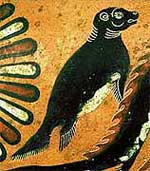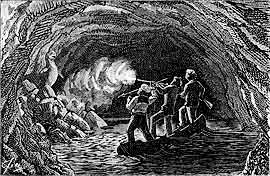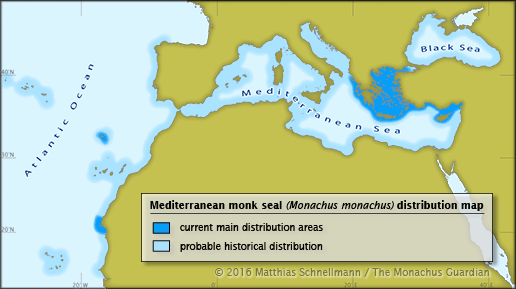 |
|
|
Dedicated to Monk Seals and their Threatened Habitats |
Monk Seal Fact FilesMediterranean Monk Seal(Monachus monachus)OverviewStatus The Mediterranean monk seal (Monachus monachus) is one of the world’s most endangered marine mammals, with fewer than 600 individuals currently surviving. The species is described as ”critically endangered” by the World Conservation Union (IUCN) and is listed on Appendix I of the Convention on International Trade in Endangered Species (CITES). Other international legal mechanisms which recognise and attempt to address the monk seal’s critically endangered status include the Bonn Convention (Convention on the Conservation of Migratory Species of Wild Animals), the Bern Convention (Convention on the Conservation of European Wildlife and Natural Habitats), the Convention on Biological Diversity and the EU Habitats Directive. History and exploitationIn ancient Greece, monk seals were placed under the protection of Poseidon and Apollo because they showed a great love for sea and sun. One of the first coins, minted around 500 BC, depicted the head of a monk seal, and the creatures were immortalized in the writings of Homer, Plutarch and Aristotle. To fishermen and seafarers, catching sight of the animals frolicking in the waves or loafing on the beaches was considered to be an omen of good fortune. Humans hunted Mediterranean monk seals for the basic necessities of their own survival – fur, oil, meat, medicines – but in early antiquity did not kill them in large enough numbers to endanger their existence as a species. 
Detail from a Caeretan hydria (water jug), c. 520-510 BC Because of their trusting nature, they were easy prey for hunters and fishermen using clubs, spears and nets. The pelts were used to make tents and were said to give protection against Nature's more hostile elements, especially lightning. The skins were also made into shoes and clothing, and the fat used for oil lamps and tallow candles. Because the animal was known to sleep so soundly, the right flipper of a seal, placed under the pillow, was thought to cure insomnia. The fat was also used to treat wounds and contusions in both humans and domestic animals. Evidence suggests that the species was severely depleted during the Roman era. Following the fall of the empire, a reduction in demand may have allowed the monk seal to stage a temporary recovery, but not to earlier population levels. Commercial exploitation peaked again in certain areas during the Middle Ages, effectively wiping out the largest surviving colonies. Increasingly, survivors no longer congregated on open beaches and headlong rocks, but sought refuge along inaccessible cliff-bound coasts and in caves (often with underwater entrances). The massive disruption of two world wars, the industrial revolution, a boom in tourism and the onset of industrial fishing all contributed to the Mediterranean monk seal’s decline and subsequent disappearance from much of its former range. TaxonomyScientific name: Monachus monachus
Why ‘Monk’ Seal?
The name ‘Monk’ seal was suggested by Johann Hermann in 1779, when the naturalist published the first modern scientific description of the species based on observations of a captive specimen found in a travelling show in Strasbourg. Hermann suggested naming the animal Münchs-Robbe (Phoca monachus), because he somewhat vaguely remembered a paper describing an animal known locally as moine in Marseille, which he concluded must be this same species. He was also reassured by contacts who had lived in Marseille that the animal was indeed called moine there. Wryly noting a monkish resemblance (the shape of the head and scapula-like shoulders) as the seal arched up on the pool edge, he judged it a well suited name, and saw no reason to change it. - Read more here. HabitatMediterranean monk seals mostly seek refuge in inaccessible caves, often along remote, cliff-bound coasts. Such caves may have underwater entrances, not visible from the water line. Known to inhabit open sandy beaches and shoreline rocks in ancient times, the occupation of such marginal habitat is believed to be a relatively recent adaptation in response to human pressures – hunting, pest eradication by fishermen, coastal urbanisation, and tourism (see Habitat deterioration). DistributionUpdated (2016) distribution map of Monachus monachus. [Go to interactive map] At one time, the Mediterranean monk seal occupied a wide geographical range. Colonies were found throughout the Mediterranean, the Marmara and Black Seas. The species also frequented the Atlantic coast of Africa, as far south as Mauritania, Senegal and the Gambia, as well as the Atlantic islands of Cape Verde, the Canary Islands, Madeira and the Azores. More recently, however, the species has disappeared from most of its former range, with the most severe contraction and fragmentation occurring during the 20th century. Nations and island groups where the monk seal has been extirpated during the past century include France and Corsica, Spain and the Balearic Islands, Italy and Sicily, Egypt, Israel and Lebanon. More recently, the species is also thought to have become extinct in the Black Sea. Despite sporadic sightings – possibly of stragglers from other regions – Monachus monachus may also be regarded as effectively extinct in Sardinia, the Adriatic coasts and islands of Croatia, and the Sea of Marmara. Reports also suggest that the monk seal may have been eradicated from Tunisia. Similarly, only a handful of individuals reportedly survive along the Mediterranean coast of Morocco. As a result of this range contraction, the monk seal has been virtually reduced to two populations, one in the northeastern Mediterranean and the other in the northeast Atlantic, off the coast of northwest Africa. Interchange between the two populations is thought improbable given the great distances separating them. Natural historyThe Mediterranean monk seal averages 2.4 m in length (nose to tail) and is believed to weigh 250-300 kg. Females are only slightly smaller than males. 
When born, pups measure 88-103 cm in length and weigh 15-20 kg. Unlike the now extinct Caribbean monk seal and the Hawaiian monk seal, Mediterranean monk seal pups are born with a white belly patch on the otherwise black to dark chocolate, woolly coat. Extirpated from much of its original habitat by human persecution and disturbance, females now tend to give birth only in caves in remote areas, often along desolate, cliff-bound coasts. Males and females are thought to reach sexual maturity between 5 and 6 years, although some females may mature as early as 4 years. Although pups may be born during any part of the year, over most of the species’ current distribution range, pupping takes place almost exclusively in autumn. Monk seal pups can swim and dive with ease by the time they are about two weeks old and are weaned at about 16-17 weeks. Monk seals are mainly thought to feed in coastal waters for fish and cephalopods, such as octopus and squid. Individuals are believed to live up to 20-30 years in the wild.
ThreatsThe main threats arrayed against the Mediterranean monk seal include: habitat deterioration and loss by coastal development, including disturbance by tourism and pleasure boating; deliberate killing by fishermen and fish farm operators, who consider the animal a pest that damages their nets and ‘steals’ their fish, particularly in depleted coastal fishing grounds; accidental entanglement in fishing gear leading to death by drowning; decreased food availability due to over-fishing pressures; so-called stochastic events, such as disease outbreaks. 
19th century seal hunt in Tunisia The Mediterranean monk seal is particularly sensitive to human disturbance, with coastal development and tourism pressures driving the species to inhabit increasingly marginal and unsuitable habitat. In some pupping caves, pups are vulnerable to storm surges and may be washed away and drowned. Unforeseen or stochastic events, such as disease epidemics, toxic algae or oil spills may also threaten the survival of the monk seal. In the summer of 1997, two thirds of the largest surviving population of Mediterranean monk seals were wiped out within the space of two months at Cabo Blanco (the Côte des Phoques) in the Western Sahara. While opinions on the precise causes of this epidemic remain sharply divided, the mass die-off emphasised the precarious status of a species already regarded as critically endangered throughout its range. ConservationConservation of the Mediterranean monk seal has been underway since the late 1970s but, given the species’ obscurity among the general public and the forces arrayed against it, progress has generally been patchy and slow. Chronic deficiencies in funding, both from state and private sources, have compounded the problem. In situ conservation efforts focus on the establishment of marine protected areas, no-fishing zones, rescue and rehabilitation of orphaned and wounded seals, education and public awareness. Scientific research, while gaining additional insights into little understood aspects of the monk seal’s biology and behaviour, can also play a key role in furthering in situ conservation aims. To date, marine protected areas for the species have been established in only a fraction of the areas scientific opinion deems necessary: in the Desertas Islands of Madeira; in the Northern Sporades Islands and northern Karpathos in Greece; on the Aegean and Mediterranean coasts of Turkey, and along the Côte des Phoques (Cabo Blanco) in the Western Sahara. Taking into consideration the feeding and breeding movements of monk seals between remnant colonies, a consensus of scientific opinion believes that a network of well-managed and guarded reserves are essential for the survival of the species. Although proposed on a number of occasions, ex situ conservation measures – such as captive breeding and translocation – have been abandoned in the face of concerted opposition from the international monk seal scientific and conservation communities. So sensitive is the monk seal to human disturbance that ex situ schemes of this kind are viewed in some quarters as an additional threat to the species. Monachus monachus has never been known to breed successfully in captivity. Scientists also question whether there is any single colony large enough to withstand the removal of donor animals for the purposes of translocation or captive breeding without jeopardising its own viability.
|
|||||||||||||||||||||||||||||||




|
Israëls, L.D.E. 1992. Thirty years of Mediterranean monk seal protection – a review. Mededelingen 28: 1-65. Johnson, W.M. 2005. In echoes of the past, the sound of the present. The Monachus Guardian 8(1): May 2005. Johnson, W.M. 2004. Monk seals
in post-classical history. The role of the
Mediterranean monk seal (Monachus monachus)
in European history and culture, from the fall of
Rome to the 20th century. Mededelingen 39. The
Netherlands Commission for International Nature
Protection, Leiden: 1-91, 31 figs. [PDF
edition Johnson, W.M. and D.M. Lavigne.
1999. Monk seals in antiquity. The Mediterranean
monk seal (Monachus monachus) in ancient
history and literature. Mededelingen 35. The
Netherlands Commission for International Nature
Protection, Leiden: 1-101., 17 figs. [PDF
edition Johnson, W.M. and D.M. Lavigne.
1998. The Mediterranean Monk Seal. Conservation
Guidelines. Multilingual Edition. International
Marine Mammal Association Inc., Guelph, Ontario,
Canada: 1-152. [PDF
Johnson, W.M. (Ed.). 1998-2010. The Monachus Guardian. Back issues of the International journal dedicated to monk seals and their threatened habitats. King, J.E. 1956. The Monk Seals (Genus Monachus). Bulletin of the British Museum (Natural History) Zoology, London Vol. 3: 201-256, 8 pls. King, J.E. 1983. Seals of the World. British Museum (Natural History) and Oxford University Press, London, Oxford: 1-240. Lavigne D.M. and W.M. Johnson. 2001. Hanging by a thread. The Monachus Guardian 4 (2): November 2001. Ronald, K. and R. Duguy (eds.). 1979. The Mediterranean monk seal. First international Conference on the Mediterranean monk seal, Rhodes, Greece, 2-5 May, 1978. United Nations Environment Programme / Pergamon Press, Oxford, UK: 1-183. |
© 2006-2017 monachus-guardian.org. All Rights Reserved.
Citation and copyright.
The Monachus GuardianMonk Seal Fact FilesMediterranean Monk Seal Acknowledgements |
